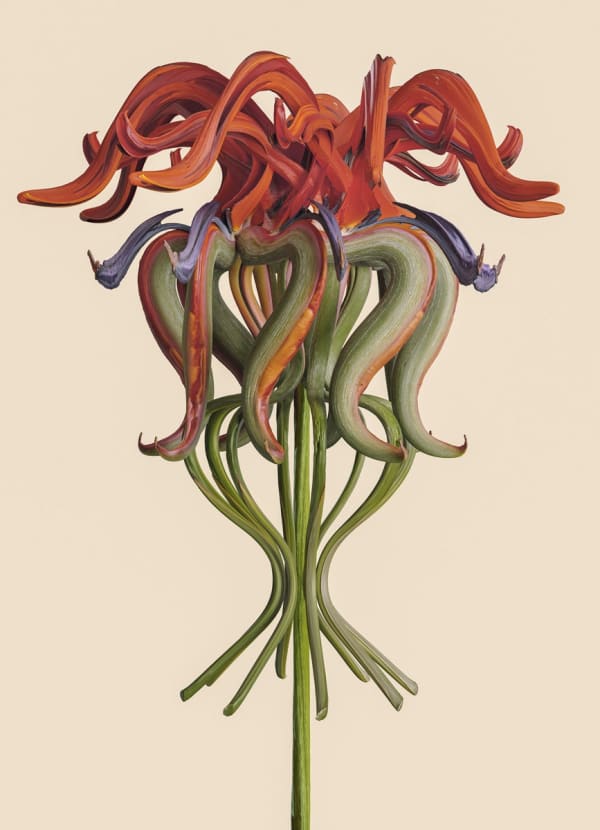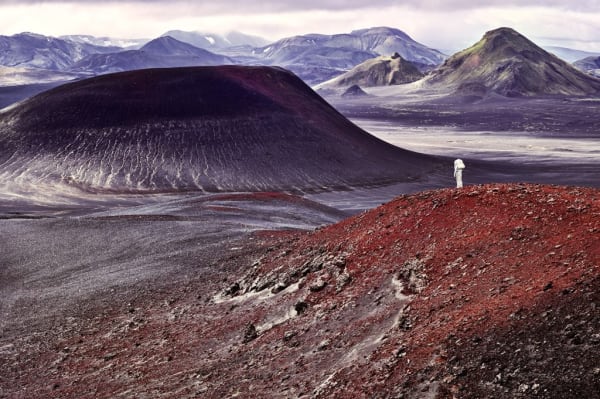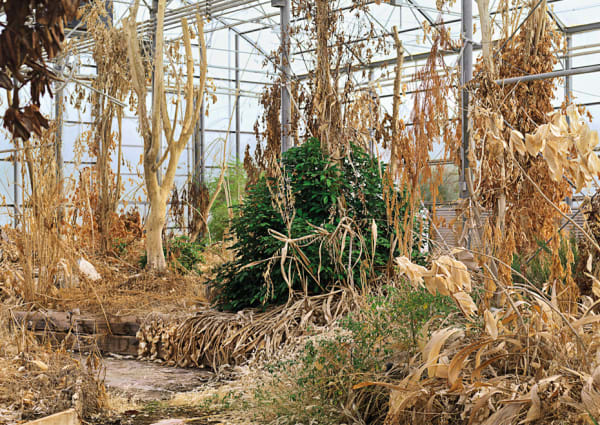'Space Utopia': Vincent Fournier
Space Utopia collects over a decade of Fournier’s work surrounding space exploration on earth. Evoking a tenacious nostalgia toward the science fiction of the twentieth century, his photographs reflect on international space travel over generations. His latest work consists of several NASA Space Centers (including Houston and Cape Canaveral) and presents the world’s most powerful rocket, SLS, which will launch astronauts in the agency’s Orion spacecraft on missions to an asteroid and eventually to Mars.
Such images remind us of a time when space was still an unknown territory; a time when the race for discovery was broadcasted worldwide in black and white. Through his eerie perspective, and sometimes humorous approach, Fournier connects these romanticised memories of the past to both the present and the possibilities of the near future - exactly 50 years after ‘one small step for man’ landed on the moon.
Fournier has had unparralled access to various NASA space and research centers alongside facilities such as the European Space Agency (ESA), the Russian space agency (Roscosmos) and the European Southern Observatory (ESO). Thus, Space Utopia not only reflects his own artistic interpretation of these space programs, but also acts as a documentation of the way humans approach outer space and adds a question mark to our utopian view on space travel as real life science fiction.
Vincent Fournier is a French fine art photographer exploring significant utopian and futuristic stories. Fournier was born in 1971 in Ouagadougou, Burkina Faso, where he spent the first five years of his life before moving to France. He earned degrees in sociology and visual arts before studying photography at the National School of Photography in Arles.
His works can be found in the permanent collections of the Metropolitan Museum of Art (MET) in New York, the Centre Pompidou Paris, and the LVMH Contemporary Art collection, among others.
Space Utopia has received the support of National Geographic, Wired, Wallpaper*, and Museums such as the Mori Art Museum in Tokyo, ArtScience Museum in Singapore and Modern Art Museum in Bologna.
Space Utopia was accompanied by an exclusive book with the same title, published by NOEVE Paris and Rizzoli New York, available at the gallery.
-
![Vincent Fournier, Anechoic Chamber, European Space Research and Technology Centre [ESTEC], Noordwijk, The Netherlands, 2008](data:image/gif;base64,R0lGODlhAQABAIAAAAAAAP///yH5BAEAAAAALAAAAAABAAEAAAIBRAA7) Vincent Fournier, Anechoic Chamber, European Space Research and Technology Centre [ESTEC], Noordwijk, The Netherlands, 2008
Vincent Fournier, Anechoic Chamber, European Space Research and Technology Centre [ESTEC], Noordwijk, The Netherlands, 2008 -
![Vincent Fournier, Anechoic Chamber, [ISAE], Toulouse, 2018](data:image/gif;base64,R0lGODlhAQABAIAAAAAAAP///yH5BAEAAAAALAAAAAABAAEAAAIBRAA7) Vincent Fournier, Anechoic Chamber, [ISAE], Toulouse, 2018
Vincent Fournier, Anechoic Chamber, [ISAE], Toulouse, 2018 -
![Vincent Fournier, Apollo Control Room, John F. Kennedy Space Center [NASA], Florida, U.S.A., 2011](data:image/gif;base64,R0lGODlhAQABAIAAAAAAAP///yH5BAEAAAAALAAAAAABAAEAAAIBRAA7) Vincent Fournier, Apollo Control Room, John F. Kennedy Space Center [NASA], Florida, U.S.A., 2011
Vincent Fournier, Apollo Control Room, John F. Kennedy Space Center [NASA], Florida, U.S.A., 2011 -
![Vincent Fournier, Baikonur City #2 [Unknown Fields Division], The International Space School VN Chelomey, Kyzylorda, Kazakhstan, 2011](data:image/gif;base64,R0lGODlhAQABAIAAAAAAAP///yH5BAEAAAAALAAAAAABAAEAAAIBRAA7) Vincent Fournier, Baikonur City #2 [Unknown Fields Division], The International Space School VN Chelomey, Kyzylorda, Kazakhstan, 2011
Vincent Fournier, Baikonur City #2 [Unknown Fields Division], The International Space School VN Chelomey, Kyzylorda, Kazakhstan, 2011 -
 Vincent Fournier, Biosphere II, Greenhouse #3, University of Arizona, O 86 racle, U.S.A., 2009
Vincent Fournier, Biosphere II, Greenhouse #3, University of Arizona, O 86 racle, U.S.A., 2009 -
![Vincent Fournier, Ergol #12, Arianespace, Guiana Space Center [CGS], Kourou, French Guiana, 2007](data:image/gif;base64,R0lGODlhAQABAIAAAAAAAP///yH5BAEAAAAALAAAAAABAAEAAAIBRAA7) Vincent Fournier, Ergol #12, Arianespace, Guiana Space Center [CGS], Kourou, French Guiana, 2007
Vincent Fournier, Ergol #12, Arianespace, Guiana Space Center [CGS], Kourou, French Guiana, 2007 -
![Vincent Fournier, Ergol #3, Arianespace, Guiana Space Center [CGS], Kourou, French Guiana, 2007](data:image/gif;base64,R0lGODlhAQABAIAAAAAAAP///yH5BAEAAAAALAAAAAABAAEAAAIBRAA7) Vincent Fournier, Ergol #3, Arianespace, Guiana Space Center [CGS], Kourou, French Guiana, 2007
Vincent Fournier, Ergol #3, Arianespace, Guiana Space Center [CGS], Kourou, French Guiana, 2007 -
![Vincent Fournier, Ergol #4, S1B clean room, Arianespace, Guiana Space Center [CGS], Kourou, French Guiana, 2011](data:image/gif;base64,R0lGODlhAQABAIAAAAAAAP///yH5BAEAAAAALAAAAAABAAEAAAIBRAA7) Vincent Fournier, Ergol #4, S1B clean room, Arianespace, Guiana Space Center [CGS], Kourou, French Guiana, 2011
Vincent Fournier, Ergol #4, S1B clean room, Arianespace, Guiana Space Center [CGS], Kourou, French Guiana, 2011 -
![Vincent Fournier, Ergol#7, Arianespace, Guiana Space Center [CGS], Kourou, French Guiana, 2007](data:image/gif;base64,R0lGODlhAQABAIAAAAAAAP///yH5BAEAAAAALAAAAAABAAEAAAIBRAA7) Vincent Fournier, Ergol#7, Arianespace, Guiana Space Center [CGS], Kourou, French Guiana, 2007
Vincent Fournier, Ergol#7, Arianespace, Guiana Space Center [CGS], Kourou, French Guiana, 2007 -
![Vincent Fournier, General Boris V., Yuri Gagarin Cosmonaut Training Center [GCTC], Star City, Zvyozdny Gorodok, Russia, 2007](data:image/gif;base64,R0lGODlhAQABAIAAAAAAAP///yH5BAEAAAAALAAAAAABAAEAAAIBRAA7) Vincent Fournier, General Boris V., Yuri Gagarin Cosmonaut Training Center [GCTC], Star City, Zvyozdny Gorodok, Russia, 2007
Vincent Fournier, General Boris V., Yuri Gagarin Cosmonaut Training Center [GCTC], Star City, Zvyozdny Gorodok, Russia, 2007 -
![Vincent Fournier, Moon Valley, Atacama desert, Lunar Robotic Research [NASA], Chile, 2007](data:image/gif;base64,R0lGODlhAQABAIAAAAAAAP///yH5BAEAAAAALAAAAAABAAEAAAIBRAA7) Vincent Fournier, Moon Valley, Atacama desert, Lunar Robotic Research [NASA], Chile, 2007
Vincent Fournier, Moon Valley, Atacama desert, Lunar Robotic Research [NASA], Chile, 2007 -
![Vincent Fournier, Phase VI space gloves Used on the International Space Station, custom made for each astronaut. [ILC] Dover, U.S.A., 2017](data:image/gif;base64,R0lGODlhAQABAIAAAAAAAP///yH5BAEAAAAALAAAAAABAAEAAAIBRAA7) Vincent Fournier, Phase VI space gloves Used on the International Space Station, custom made for each astronaut. [ILC] Dover, U.S.A., 2017
Vincent Fournier, Phase VI space gloves Used on the International Space Station, custom made for each astronaut. [ILC] Dover, U.S.A., 2017 -
![Vincent Fournier, SLS rocket Systems Integration #1, Marshall Space Flight Center, Alabama, Huntsville,[NASA], U.S.A., 2017](data:image/gif;base64,R0lGODlhAQABAIAAAAAAAP///yH5BAEAAAAALAAAAAABAAEAAAIBRAA7) Vincent Fournier, SLS rocket Systems Integration #1, Marshall Space Flight Center, Alabama, Huntsville,[NASA], U.S.A., 2017
Vincent Fournier, SLS rocket Systems Integration #1, Marshall Space Flight Center, Alabama, Huntsville,[NASA], U.S.A., 2017 -
![Vincent Fournier, SLS rocket Systems Integration #2, Marshall Space Flight Center, Alabama, Huntsville,[NASA], U.S.A., 2017](data:image/gif;base64,R0lGODlhAQABAIAAAAAAAP///yH5BAEAAAAALAAAAAABAAEAAAIBRAA7) Vincent Fournier, SLS rocket Systems Integration #2, Marshall Space Flight Center, Alabama, Huntsville,[NASA], U.S.A., 2017
Vincent Fournier, SLS rocket Systems Integration #2, Marshall Space Flight Center, Alabama, Huntsville,[NASA], U.S.A., 2017 -
![Vincent Fournier, SOUSY Svalbard Radar [SSR], Svalbard, Norway, 2010](data:image/gif;base64,R0lGODlhAQABAIAAAAAAAP///yH5BAEAAAAALAAAAAABAAEAAAIBRAA7) Vincent Fournier, SOUSY Svalbard Radar [SSR], Svalbard, Norway, 2010
Vincent Fournier, SOUSY Svalbard Radar [SSR], Svalbard, Norway, 2010 -
 Vincent Fournier, Space Odyssey spacesuit #1, Sylmar, USA, 2019
Vincent Fournier, Space Odyssey spacesuit #1, Sylmar, USA, 2019 -
![Vincent Fournier, Space Shuttle Discovery Nose Landing Gear, J.F.K. Space Center [NASA], Florida, U.S.A., 2011](data:image/gif;base64,R0lGODlhAQABAIAAAAAAAP///yH5BAEAAAAALAAAAAABAAEAAAIBRAA7) Vincent Fournier, Space Shuttle Discovery Nose Landing Gear, J.F.K. Space Center [NASA], Florida, U.S.A., 2011
Vincent Fournier, Space Shuttle Discovery Nose Landing Gear, J.F.K. Space Center [NASA], Florida, U.S.A., 2011 -
 Vincent Fournier, Subsonic Wind Tunnel#2, NASA’s Langley Research Center, Hampton, Virginia, USA, 2017
Vincent Fournier, Subsonic Wind Tunnel#2, NASA’s Langley Research Center, Hampton, Virginia, USA, 2017 -
![Vincent Fournier, Svalsat#1 [KSAT], Adventdalen, Spitsbergen Island, Norway, 2010](data:image/gif;base64,R0lGODlhAQABAIAAAAAAAP///yH5BAEAAAAALAAAAAABAAEAAAIBRAA7) Vincent Fournier, Svalsat#1 [KSAT], Adventdalen, Spitsbergen Island, Norway, 2010
Vincent Fournier, Svalsat#1 [KSAT], Adventdalen, Spitsbergen Island, Norway, 2010
-

It’s Springtime on Polaris-9b, and the Exoflowers Are Blooming
An artist imagines the flora of distant, nonexistent worlds.Emily Anthes, The New york Times, April 20, 2025 -

Vincent Fournier: a time traveler taking the past into the future / In conversation with Alice Zucca
Alice Zucca, XIBT, April 17, 2020
![Vincent Fournier Phase VI space gloves Used on the International Space Station, custom made for each astronaut. [ILC] Dover, U.S.A., 2017 Inkjet on Hahnemuhle Baryta Paper, white hand painted wooden frame with art glass 130 x 100 cm 2/10 + 2 AP Series: Space Utopia](https://artlogic-res.cloudinary.com/w_500,h_500,c_limit,f_auto,fl_lossy,q_auto/artlogicstorage/theravestijngallery/images/view/3e6afecd1ebf0a4e0238ae34aafdd4f4j/theravestijngallery-vincent-fournier-phase-vi-space-gloves-used-on-the-international-space-station-custom-made-for-each-astronaut.-ilc-dover-u.s.a.-2017.jpg)
![Vincent Fournier, Anechoic Chamber, European Space Research and Technology Centre [ESTEC], Noordwijk, The Netherlands, 2008](https://artlogic-res.cloudinary.com/w_600,c_limit,f_auto,fl_lossy,q_auto/artlogicstorage/theravestijngallery/images/view/3c794253564b0acc41fb804f36b203ccj/theravestijngallery-vincent-fournier-anechoic-chamber-european-space-research-and-technology-centre-estec-noordwijk-the-netherlands-2008.jpg)
![Vincent Fournier, Anechoic Chamber, [ISAE], Toulouse, 2018](https://artlogic-res.cloudinary.com/w_600,c_limit,f_auto,fl_lossy,q_auto/artlogicstorage/theravestijngallery/images/view/14f5f314e6e47472fefc8492af30c409j/theravestijngallery-vincent-fournier-anechoic-chamber-isae-toulouse-2018.jpg)
![Vincent Fournier, Apollo Control Room, John F. Kennedy Space Center [NASA], Florida, U.S.A., 2011](https://artlogic-res.cloudinary.com/w_600,c_limit,f_auto,fl_lossy,q_auto/artlogicstorage/theravestijngallery/images/view/539317e98af0b61bdaf1f67d7370b600j/theravestijngallery-vincent-fournier-apollo-control-room-john-f.-kennedy-space-center-nasa-florida-u.s.a.-2011.jpg)
![Vincent Fournier, Baikonur City #2 [Unknown Fields Division], The International Space School VN Chelomey, Kyzylorda, Kazakhstan, 2011](https://artlogic-res.cloudinary.com/w_600,c_limit,f_auto,fl_lossy,q_auto/artlogicstorage/theravestijngallery/images/view/a2112c9e5c2125f0a9620ee22c83d1b2j/theravestijngallery-vincent-fournier-baikonur-city-2-unknown-fields-division-the-international-space-school-vn-chelomey-kyzylorda-kazakhstan-2011.jpg)

![Vincent Fournier, Ergol #12, Arianespace, Guiana Space Center [CGS], Kourou, French Guiana, 2007](https://artlogic-res.cloudinary.com/w_600,c_limit,f_auto,fl_lossy,q_auto/artlogicstorage/theravestijngallery/images/view/9fe6b75729170d7d09fb5e417784f9a8j/theravestijngallery-vincent-fournier-ergol-12-arianespace-guiana-space-center-cgs-kourou-french-guiana-2007.jpg)
![Vincent Fournier, Ergol #3, Arianespace, Guiana Space Center [CGS], Kourou, French Guiana, 2007](https://artlogic-res.cloudinary.com/w_600,c_limit,f_auto,fl_lossy,q_auto/artlogicstorage/theravestijngallery/images/view/76d73e3a2161dd950a64d01f916b253ej/theravestijngallery-vincent-fournier-ergol-3-arianespace-guiana-space-center-cgs-kourou-french-guiana-2007.jpg)
![Vincent Fournier, Ergol #4, S1B clean room, Arianespace, Guiana Space Center [CGS], Kourou, French Guiana, 2011](https://artlogic-res.cloudinary.com/w_600,c_limit,f_auto,fl_lossy,q_auto/artlogicstorage/theravestijngallery/images/view/8df07d71c4352ecb71510c785346d392j/theravestijngallery-vincent-fournier-ergol-4-s1b-clean-room-arianespace-guiana-space-center-cgs-kourou-french-guiana-2011.jpg)
![Vincent Fournier, Ergol#7, Arianespace, Guiana Space Center [CGS], Kourou, French Guiana, 2007](https://artlogic-res.cloudinary.com/w_600,c_limit,f_auto,fl_lossy,q_auto/artlogicstorage/theravestijngallery/images/view/3af1f787786e4ea71686fa3ae213e85aj/theravestijngallery-vincent-fournier-ergol-7-arianespace-guiana-space-center-cgs-kourou-french-guiana-2007.jpg)
![Vincent Fournier, General Boris V., Yuri Gagarin Cosmonaut Training Center [GCTC], Star City, Zvyozdny Gorodok, Russia, 2007](https://artlogic-res.cloudinary.com/w_600,c_limit,f_auto,fl_lossy,q_auto/artlogicstorage/theravestijngallery/images/view/c56acfc31296a38f5df8d8587bc48ab6j/theravestijngallery-vincent-fournier-general-boris-v.-yuri-gagarin-cosmonaut-training-center-gctc-star-city-zvyozdny-gorodok-russia-2007.jpg)
![Vincent Fournier, Moon Valley, Atacama desert, Lunar Robotic Research [NASA], Chile, 2007](https://artlogic-res.cloudinary.com/w_600,c_limit,f_auto,fl_lossy,q_auto/artlogicstorage/theravestijngallery/images/view/edfff725bb5259d11b3c06a5098a8616j/theravestijngallery-vincent-fournier-moon-valley-atacama-desert-lunar-robotic-research-nasa-chile-2007.jpg)
![Vincent Fournier, Phase VI space gloves Used on the International Space Station, custom made for each astronaut. [ILC] Dover, U.S.A., 2017](https://artlogic-res.cloudinary.com/w_600,c_limit,f_auto,fl_lossy,q_auto/artlogicstorage/theravestijngallery/images/view/3e6afecd1ebf0a4e0238ae34aafdd4f4j/theravestijngallery-vincent-fournier-phase-vi-space-gloves-used-on-the-international-space-station-custom-made-for-each-astronaut.-ilc-dover-u.s.a.-2017.jpg)
![Vincent Fournier, SLS rocket Systems Integration #1, Marshall Space Flight Center, Alabama, Huntsville,[NASA], U.S.A., 2017](https://artlogic-res.cloudinary.com/w_600,c_limit,f_auto,fl_lossy,q_auto/artlogicstorage/theravestijngallery/images/view/794ebc06891bd2faa795726f61c488c5j/theravestijngallery-vincent-fournier-sls-rocket-systems-integration-1-marshall-space-flight-center-alabama-huntsville-nasa-u.s.a.-2017.jpg)
![Vincent Fournier, SLS rocket Systems Integration #2, Marshall Space Flight Center, Alabama, Huntsville,[NASA], U.S.A., 2017](https://artlogic-res.cloudinary.com/w_600,c_limit,f_auto,fl_lossy,q_auto/artlogicstorage/theravestijngallery/images/view/c042519e76f603e10d0dda644d1d060dj/theravestijngallery-vincent-fournier-sls-rocket-systems-integration-2-marshall-space-flight-center-alabama-huntsville-nasa-u.s.a.-2017.jpg)
![Vincent Fournier, SOUSY Svalbard Radar [SSR], Svalbard, Norway, 2010](https://artlogic-res.cloudinary.com/w_600,c_limit,f_auto,fl_lossy,q_auto/artlogicstorage/theravestijngallery/images/view/cbec7d6a567015f21845e2c1639647abj/theravestijngallery-vincent-fournier-sousy-svalbard-radar-ssr-svalbard-norway-2010.jpg)

![Vincent Fournier, Space Shuttle Discovery Nose Landing Gear, J.F.K. Space Center [NASA], Florida, U.S.A., 2011](https://artlogic-res.cloudinary.com/w_600,c_limit,f_auto,fl_lossy,q_auto/artlogicstorage/theravestijngallery/images/view/8261a23de8d7095e18ab1fd0beab765aj/theravestijngallery-vincent-fournier-space-shuttle-discovery-nose-landing-gear-j.f.k.-space-center-nasa-florida-u.s.a.-2011.jpg)

![Vincent Fournier, Svalsat#1 [KSAT], Adventdalen, Spitsbergen Island, Norway, 2010](https://artlogic-res.cloudinary.com/w_600,c_limit,f_auto,fl_lossy,q_auto/artlogicstorage/theravestijngallery/images/view/8e8d3a638efb3557f7191723e203d61cj/theravestijngallery-vincent-fournier-svalsat-1-ksat-adventdalen-spitsbergen-island-norway-2010.jpg)

